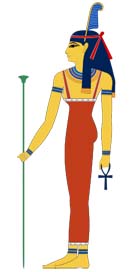Ma'at | The Goddess Of Truth And Justice
Ma'at (aka Maat) was the ancient Egyptian concept of cosmic order and balance. The philosophy of Ma’at allowed them to rationalize the events occurring around them. As long as the universe revolved around Ma’at there would be a purity that ensured balance and justice. Through this ideology, Ma’at became the basis of Egyptian culture.
The Ma'at concept was personified as the goddess of truth and justice. From the earliest eras in Egypt, people considered her as essential for the stability of life. She represented truth, justice, harmony and balance. The opposite of chaos, Ma’at gave order to nature and society. Reaching beyond being simply a goddess, Ma’at became a focus for leadership, philosophy and law.
Born a Goddess Over All Creation
Historians found the first written accounts of Ma’at in the Pyramid Texts, written between 2375 and 2345 BCE. However, the divine concept of the goddess is a much older idea. Ma’at is a central figure in the Egyptian creation story. She was with her father Ra on his celestial barque, or sailing boat, as he came from the waters with the Egyptian gods and goddesses.
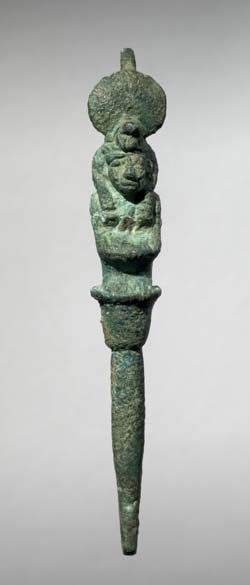
© Ashley Van Haeften - Figurine of Goddess Ma'at
Egyptians saw Ra as the most important god in Egyptian society. He made Ma'at even more important by standing on her pedestal to establish all creation. This placed Ma’at as the order that transformed chaos into creation. She ruled both gods and people.
Over time, Ma’at developed beyond being simply the daughter of Ra and responsible for order to being the reason that the universe existed. Some of her other responsibilities include:
- Relationships
- The cycle of seasons
- The movements of the sun, moon and stars
- All parts of religion
- How people behaved
- The positive characteristics of men
- Rulers, leaders and judges
- The afterlife
Historical texts transform Ma'at from a goddess to actually being creation. In many instances, ancient Egyptians considered their society and religion to be "Ma'at", while the wilderness and other cultures were considered chaotic and unjust.
The Ideal Egyptian Woman
Ma’at is often represented as a slim woman with a white ostrich feather on her head. She often carries a scepter or an ankh. Some ancient representations feature Ma’at with wings of divinity outstretched. Egyptians viewed her slim figure and symmetrical features to represent the appearance of the perfect Egyptian woman.
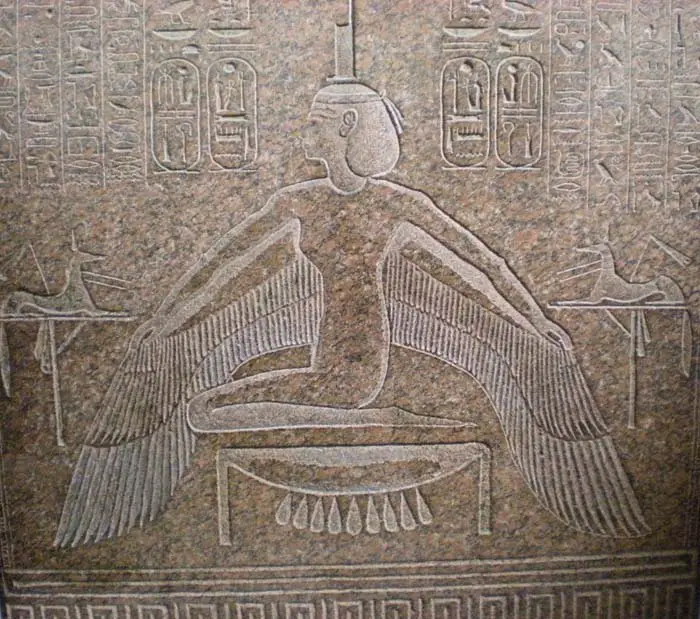
© genibee - sarcophagus with Ma'at
The symbol of Ma’at is a primeval mound. The symbol represents Ma’at as being the mound on which the gods stood upon when creating the universe. Other symbols associated with Ma'at are the ostrich feather and scales.
Family Tree
- Father: Ra, the sun god.
- Sister: Shu, the air god.
- Husband: Thoth, the moon god
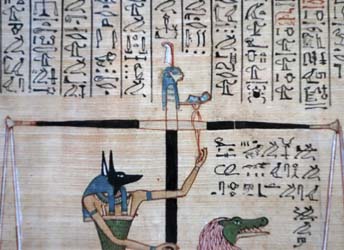
© Steven Zucker - Detail of Ma'at
Role as a Goddess
Ma’at ruled everything, which made her a very busy goddess. Every day she helped Ra to steer his boat across the sky, making a path for the sun. She was the partner of Thoth and the mother of the eight deities known as the Chief Gods and Goddesses of Hermopolis.
Beyond being the force which kept the Egypt functioning as an orderly society, Ma’at held an important role in the afterlife. She not only kept order among the living, but served as the judge of the afterlife.
Ma'at's ability to view truth and justice was key in judging a soul.
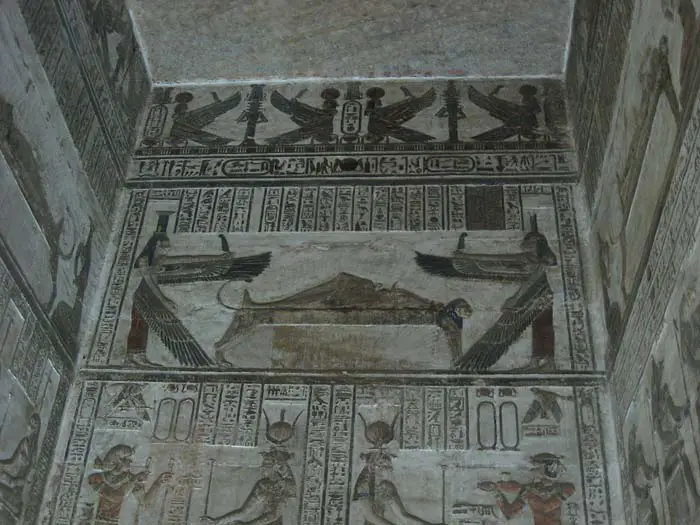
© Karen Green - Osiris room at Dendera -- Ma'at flanks Osiris mummy
When an Egyptian died, the process of mummification included leaving the heart within the body. Egyptians considered the heart to be the soul of the person, by which he or she would be judged in the afterlife. After death, Ma’at would judge the hearts of the dead in Osiris’s Judgment Halls of the Dead. Once the dead reached the halls, Ma’at would weigh the heart of each person against the weight of her ostrich feather. If the heart weighed the same or less than the feather, they were considered just and worthy of continuing into the Duat, or everlasting afterlife.
If the scales indicated that the heart was heavier than the feather, then the person was shown to not be a follower of Ma’at during his or her life. The consequence of this was that the deceased was refused an afterlife and the heart was eaten by a demon. In some versions of the judgment, the crocodile-headed Ammut would devour the entire person.
More Than Just a Goddess
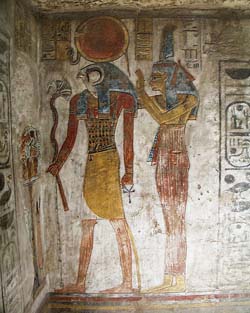
© euphbass - Ra & Ma'at
The many different names of Ma’at give an idea of her importance to Egyptian society. Egyptians referred to Ma’at as:
- Eye of Ra
- Mistress of the Underworld
- Queen of the Earth
- Lady of Heaven
- Lady of the Gods and Goddesses
Egyptians saw Ma’at as an everlasting goddess. By representing order, she became the most important goddess of ancient Egypt.
Pharaohs Worshiped Ma’at
Pharaohs in ancient Egypt weren’t simply rulers, but were also seen as gods. The idea that all gods worshiped and respected Ma’at meant that the pharaohs of Egypt must also seek Ma’at in order to prosper. Egyptians believed that if a pharaoh did not follow Ma’at, the chaos would return and destroy the world.
Many pharaohs wanted to show that Ma’at blessed them and that they were everything Ma’at represented. Wanting to be seen as good leaders, they would often call themselves the “Lords of Ma’at.” This showed that they had truth and justice in their hearts. Egypt’s pharaohs often took great efforts to discredit previous rulers. This practice strengthened their position of power. By saying that the previous pharaoh did not have Ma’at in his heart, the current pharaoh would position himself as the savior of Egypt by restoring truth, justice and order.
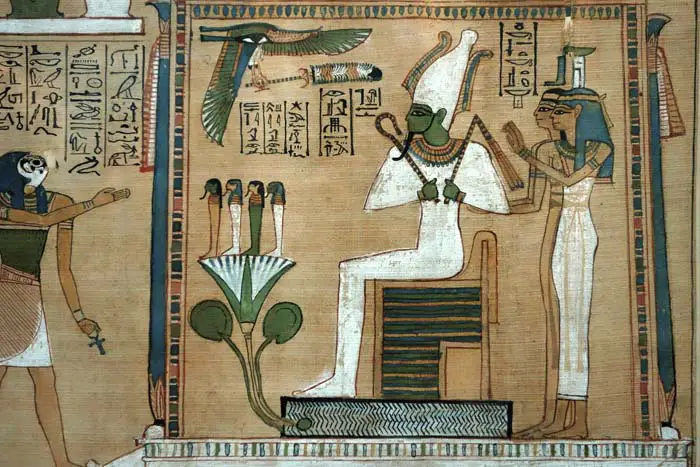
© Steven Zucker - Hunefer's Book of the Dead, detail with Horus and pavilion
Legally Speaking
Because Egyptians saw Ma'at as the judge of souls in the afterlife, Egyptian judges based Egyptian law on the teachings of Ma'at. The spirit of Ma'at became the idea behind how Egyptian judges applied justice. Starting in the fifth dynasty, Egyptians referred to the head of justice as the "Priest of Ma'at." After 2370 BCE, judges continued to wear the image of Ma'at while on duty.
Egyptian judges believed that justice and fairness equaled peace and harmony. In order to have a peaceful society, justice through Ma'at was very important.
Facts About Ma'at
- Ma'at became the basis of Egyptian culture
- She represented leadership, philosophy and law
- Ra placed Ma'at at the center of all creation
- She was worshiped by pharaohs, who often called themselves "Lords of Ma'at"

